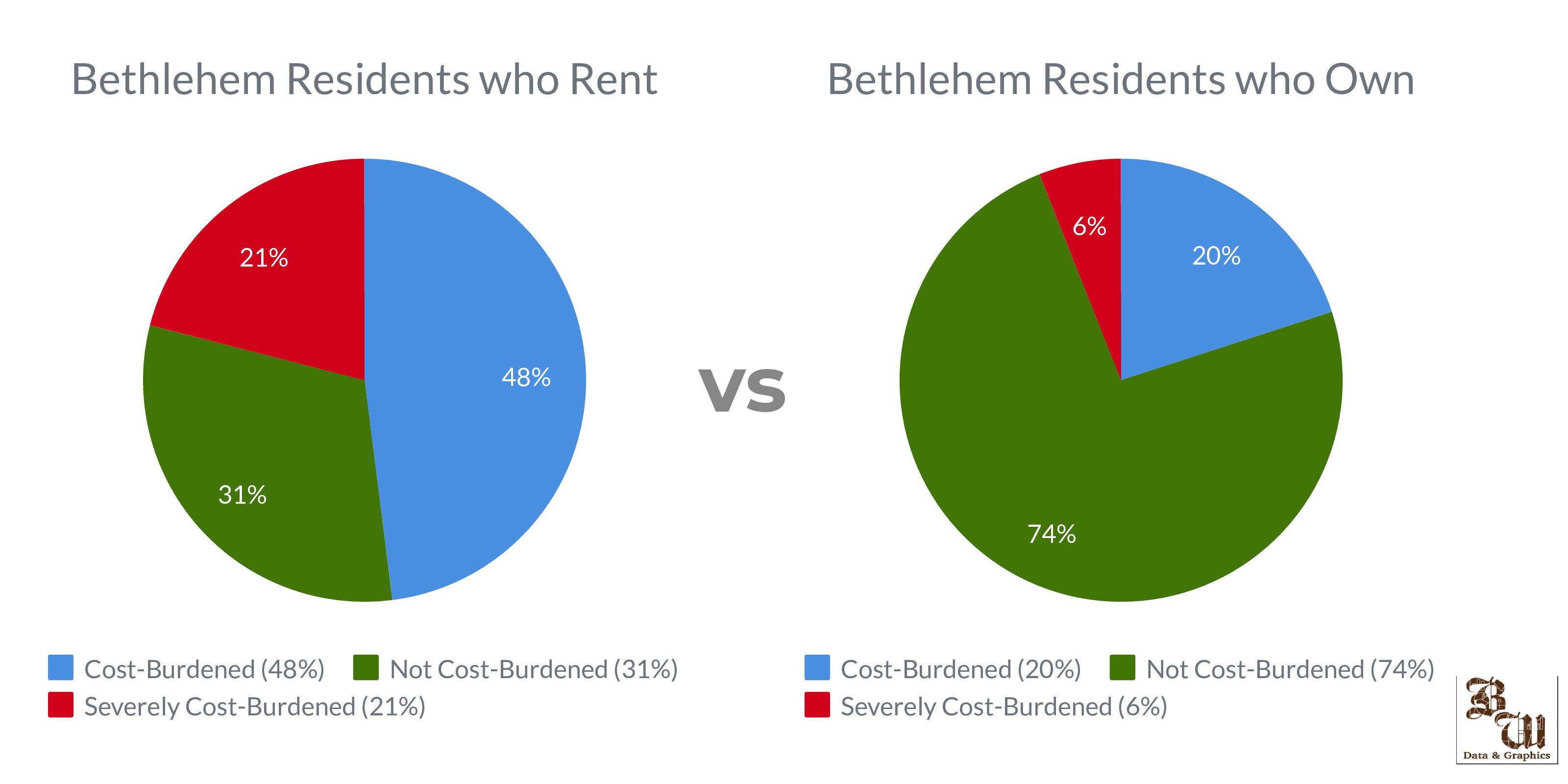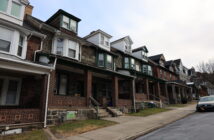In Bethlehem, 48 percent of home renters are cost-burdened and 21 percent are severely cost-burdened. 20 percent of homeowners are cost-burdened and 6 percent are severely cost-burdened, according to housing data.
Being cost-burdened is defined as the inability to afford housing. The term applies to those who spend more than 30 percent of their household income on rent. Being severely cost-burdened is when someone spends more than 50 percent of their income on housing.
In the past few years, there has been an increase in property values on the South Side of Bethlehem, making housing less affordable for residents.
In response, Bethlehem’s City Council approved the Zoning Ordinance related to the Student Housing Zoning District in 2020 to address affordable housing options on the South Side.
Anna Smith, a South Bethlehem resident, previously worked as director of the Community Action Development Corporation of Bethlehem. Part of her role was looking at sale prices of residential housing on the South Side every six months.
At the beginning of 2018, she identified a rapid increase in housing sale prices on the South Side over the past year.
She said usually there was an increase of less than 10 percent each year, but this increase was around 18 percent.
Smith said she found that more houses were being bought and sold on the South Side than in previous years, including purchases of homes by limited liability corporations (LLCs).
Some of these purchases happened on Upper Hillside or First Terrace, areas where student housing did not typically exist in significant numbers.

The student housing zoning ordinance was created in 2020 to limit the spread of off-campus student housing. Students living off campus create challenges for offering affordable housing to Bethlehem residents. (Gabi Falk/B&W Staff)
According to U.S. Census data, half of households in the city of Bethlehem rent their homes and the other half are homeowners.
On the South Side, 70 percent of residents rent their homes and 30 percent are homeowners.
Smith said renters are more likely to be people of color since only 37 percent of renters are white. 70 percent of Hispanic families and 77 percent of Black families are renters in the city of Bethlehem.
She said 63 percent of homeowners are white, 30 percent are Hispanic and 23 percent are Black.
The median rent in South Bethlehem ranges from $500 to $1,200 per home, according to the Census data.
A subsidized housing voucher from the Lehigh Valley Fair Market Rent is $1,327 for a three bedroom or $1,599 for a five bedroom.
Student housing rents fall between $400 to $1,000 per bedroom or $2,000 to $5,000 per home, Smith said.
She said landlords who rent student homes can earn about $5,000 a month when the rent is split among five students. The same home rented out to a family wouldn’t rent for more than about $1,500 a month.
Low priced five bedrooms exceed the Fair Market Rent, which make those homes inaccessible for those with housing vouchers and unaffordable for individuals and families making less than $80,000 per year.
The median household income of homeowners in Bethlehem is $76,848 and the median income of renters is $35,682.
To address the issue of affordable housing on the South Side, at the end of 2018, a housing policy expert from Philadelphia was hired to look at what other communities with major universities have done to regulate student housing.
Smith said Muhlenberg College implemented a student housing overlay district in the 90s, and other schools have taken the approach of a zoning ordinance to restrict student homes to a particular area.
Bethlehem’s Zoning Ordinance was passed unanimously in the spring of 2020.
“What the ordinance essentially says is that all existing student housing before the date of the passage of the ordinance could remain where it is, as long as it’s licensed and inspected every year,” she said. “It can remain a student housing, but anyone who wants to turn a home into student housing that isn’t currently can only do so within two very specific zones, one on each side of campus that are already predominantly student homes.”
She said students can still live anywhere in the city of Bethlehem, however, if they are living outside of the student housing zone, there cannot be more than two students living in a home.
Rachel Leon, another local resident, grew up on the South Side of Bethlehem.
“There’s this idea that when we talk about affordable housing we are talking about low income housing which we are not at all,” Leon said. “We just mean affordable to what the residents of South Bethlehem make.”
She said luxury apartments are being built beyond the prices that the demographic living in South Bethlehem can afford.
Leon said the city should invest more in helping community members keep their houses up to code and to mitigate lead and asbestos.
“Many people that sell their homes sell them at a loss and they sell them to real estate companies and developers because they can’t afford to bring them up to code themselves,” she said. “If the city were to invest in the community that is already there, they would be less likely to sell at a loss, or sell to a developer and more likely to sell to a family.”
Leon said South Bethlehem is becoming increasingly overdeveloped and crowded as Lehigh grows its student body.
She said other issues in addition to the lack of affordable housing include the loss of the historic district, as well as the future environmental impacts of housing being built.
She said the increase in housing needs pushes the Historic Conservation Committee to allow for seven, eight, nine story buildings on the South Side, even though it’s a historic district.
Grace Crampsie Smith, a Bethlehem City Council Member, said the number one cause of homelessness is the lack of affordable housing.
“A big concern of the South Side is people are needing to move because they can no longer afford rent or home ownership,” she said. “People are feeling a loss of the community with the influx of high end, luxury apartments.”
Crampsie Smith said residents feel they are losing a sense of community with more students coming to the area.
She said she started an affordable housing task force last year that met with developers and those who work in affordable housing.
Crampsie Smith said Bethlehem is one of five cities recently picked to participate in an NYU housing solutions workshop.
She said another solution is offering developers tax breaks and incentives to offer affordable housing.
“We need to give incentives to the developers so they are willing to do more housing that is affordable,” Crampsie Smith said. “We have to look at trying to maintain the housing that is affordable now and keep it that way as well as build more affordable units.”






Comment policy
Comments posted to The Brown and White website are reviewed by a moderator before being approved. Incendiary speech or harassing language, including comments targeted at individuals, may be deemed unacceptable and not published. Spam and other soliciting will also be declined.
The Brown and White also reserves the right to not publish entirely anonymous comments.